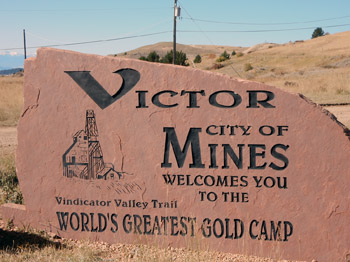
Victor, Colorado
by Dedra Montoya
“I think we’re kinda stuck in 1900,” says the owner of the Victor Trading Company, Sam Morrison. Walking into the Victorian building in the center of the little gold-mining town of Victor, Colorado, (where time seems to have stood still for over a century), you get the sense you’re wandering back in time.
The wood floor creaks under your step, and the musty scent of 100-plus years of history, spiked with an earthy smell of freshly harvested grasses, billows through your senses. A canopy of curiosities draws your eye to the ceiling where old brooms, wire baskets and a tin man dangle from pipes and wires. A taxidermy wild pig and a headless 1800s doll live on high-up shelves with ancient wooden crates. If you look closely you’ll spot the crate that bears the words re-concentrated embalming fluid. Barely a square inch of wall space is left uninhabited by something whimsical and old.
And then your gaze settles on the vast wall adorned with what Sam and his wife, Karen, claim is the “world’s largest broom collection.” On it perch brooms dating back as long as a couple of hundred years—each a work of art, each with a story to tell if brooms could talk. Below that wall Sam and Karen craft the handmade brooms that have made their livelihood for the past 27 years.
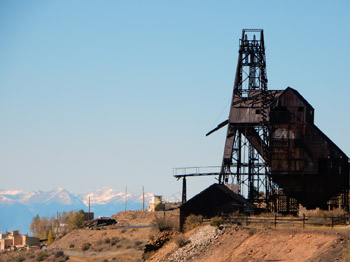 Rainbow colored piles of bound organic natural and dyed grasses are stacked against the wall. That’s the earthy aroma that meets you at the front door. The rhythmic whir of the foot-pedaled 1900 broom winder clicks and hums as Sam’s deft hands stitch together the layers of broom corn—a kind of sorghum—using a huge double-ended needle that he pushes through the broom. Medieval looking sewing cuffs made of well worn leather with metal disc inserts protect the palms of his hands from a wicked needle jab.
Rainbow colored piles of bound organic natural and dyed grasses are stacked against the wall. That’s the earthy aroma that meets you at the front door. The rhythmic whir of the foot-pedaled 1900 broom winder clicks and hums as Sam’s deft hands stitch together the layers of broom corn—a kind of sorghum—using a huge double-ended needle that he pushes through the broom. Medieval looking sewing cuffs made of well worn leather with metal disc inserts protect the palms of his hands from a wicked needle jab.
With names like Brunhilda, Grandpa’s Workshop, and Grandma’s Kitchen, the many styles of brooms are sturdy and hefty with handles made of hard beech wood. (“The cheap brooms are made of pine,” says Karen.) Each broom style has its own name, its own personality, its own job to do. There are miniature brooms for small jobs, long-handled brooms to catch spider webs, serious brooms for serious work, and the artistically curved little Ebenezer. He’s a turkey wing whisk broom.
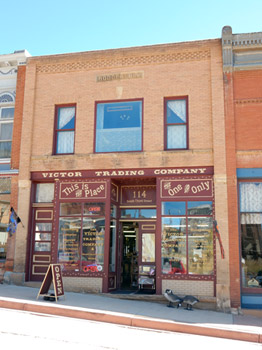 You don’t usually think of a broom as a thing of beauty, but these brooms are more than that. They’re artful. Functional and long-lasting, their craftsmanship belies the notion that “they sure don’t make things the way they used to” because Sam and Karen’s brooms are made the old-fashioned way, with artistry, attention to detail, and by hand.
You don’t usually think of a broom as a thing of beauty, but these brooms are more than that. They’re artful. Functional and long-lasting, their craftsmanship belies the notion that “they sure don’t make things the way they used to” because Sam and Karen’s brooms are made the old-fashioned way, with artistry, attention to detail, and by hand.
“People have no idea they need a broom until they come in here,” Karen giggles. She says that it’s usually the women who come in to shop, but when their reluctant guys slump in, the women can’t get them out once they get a load of all the antique tools and equipment!
The Morrisons even make a line of historically accurate period brooms that have been used as stage props at the Metropolitan Opera, the San Francisco Opera and the Cincinnati Playhouse. Some of their brooms have even had roles in movies such as Little Women, The Missing, and Into the West. One is living in the Smithsonian’s new American Heritage exhibit.
The machines the self-taught broom makers use in the manufacturing of their brooms are antique, dating back to the early 1900’s. Sam’s penchant for working relics led him to find obscure, derelict machines and, with his extraordinary know-how, bring them back to life.
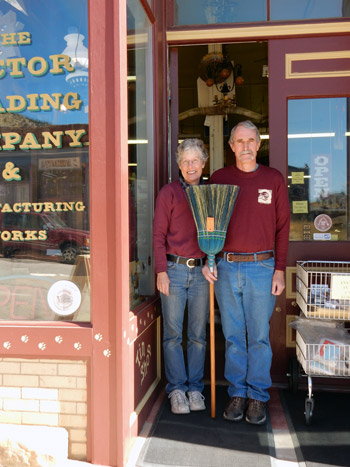 “There’s a romance to this that you don’t find in your computers because computers aren’t fun to watch,” Sam opines. Romance, indeed. And you see what he means when you watch the gears and cogs and wheels and treadles of the cast iron antiquities move with rhythmic simplicity and complexity to create things that people use and need.
“There’s a romance to this that you don’t find in your computers because computers aren’t fun to watch,” Sam opines. Romance, indeed. And you see what he means when you watch the gears and cogs and wheels and treadles of the cast iron antiquities move with rhythmic simplicity and complexity to create things that people use and need.
There is no assembly line here. There are no employees. Just Sam and Karen making each and every broom themselves at a rate of five or six a day, all made to order. “We’ve stitched well over 20,000 brooms,” says Sam. When asked which broom is their favorite, Karen replies, “We can’t pick one because we made them all!” Hmmm…kind of like asking who is your favorite child.
The Morrisons live upstairs with Cinder, their grumpy 15-year-old tortie cat who has free reign of the place. Their home and business have existed for 24 years in the building that used to be the Star of the West Saloon downstairs and a boarding house upstairs.
Back in the gold rush days of the late 19th and early 20th centuries there were 37 saloons in the tiny town. The miners lived in the boarding houses and row houses of Victor, while the wealthy mine owners and investors lived in nearby bustling Cripple Creek.
Sam and Karen say their home is slightly haunted. They are convinced of the presence of George Rodgers who owned the Star of the West and lived upstairs back in 1896. The original wood building burned down in 1899 when a fire, as the story goes, started in the red light district and blew through Victor, destroying the entire Victor business district.
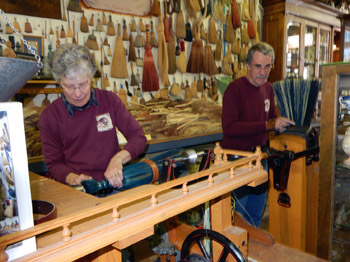 George Rodgers rebuilt the blonde brick building that exists now and bears the name “Rodgers BLK” at the top of it. George died in his upstairs abode in 1901 on the day that President William McKinley was assassinated. The Morrisons say George is a bit of a practical joker. Things seem to move from where they were put. There’s a clinking noise like that of a barrel bolt on the bathroom door every night around 9:00 that causes the cat to startle and hiss. And then, there’s the cigar smoke they get a whiff of every now and then. The Morrisons do not smoke cigars. But there is no fear where George is concerned. Sam and Karen think he’s happy they have the building. He’s become a family friend.
George Rodgers rebuilt the blonde brick building that exists now and bears the name “Rodgers BLK” at the top of it. George died in his upstairs abode in 1901 on the day that President William McKinley was assassinated. The Morrisons say George is a bit of a practical joker. Things seem to move from where they were put. There’s a clinking noise like that of a barrel bolt on the bathroom door every night around 9:00 that causes the cat to startle and hiss. And then, there’s the cigar smoke they get a whiff of every now and then. The Morrisons do not smoke cigars. But there is no fear where George is concerned. Sam and Karen think he’s happy they have the building. He’s become a family friend.
Sam Morrison has had a love of history and an appreciation of all things antique and utilitarian since he was a child, and it certainly shows when you look around the emporium the Morrisons call a “working museum”. You get the sense he would have loved living during the time of the Industrial Revolution.
Though brooms take center stage, there is also the 1894 Chandler and Price clamshell printing press that sits unassumingly on the other side of the aisle. Loyal customers, Dave and Leslie who live 47 miles away in Manitou Springs, make the drive to Victor every year to get their Christmas cards that are made on that press.
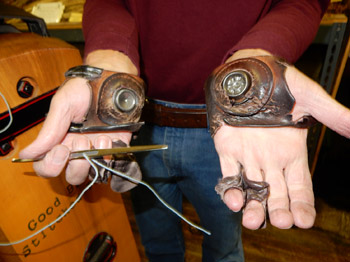 Customers are drawn to the Victor Trading Company by word of mouth and come again and again. The Morrisons do business on a first-name basis and consider their customers close friends. “If we don’t make it, they don’t want it,” Karen says, referring to the fact that people who frequent the store are not interested in any of the factory-made stuff they may have on a shelf or two.
Customers are drawn to the Victor Trading Company by word of mouth and come again and again. The Morrisons do business on a first-name basis and consider their customers close friends. “If we don’t make it, they don’t want it,” Karen says, referring to the fact that people who frequent the store are not interested in any of the factory-made stuff they may have on a shelf or two.
Among other handmade items to be had are historically accurate tin cans wearing labels from the 1880’s to the 1920’s (some of which can be seen in shop windows as far away as Disneyland Hong Kong), hand-dipped candles, and custom tin cookie cutters, including dog biscuit cookie cutters—all crafted by Karen using antique, authentic equipment and tools.
It’s hard not to get swept up in the historical significance, cluttered whimsy, and…yes…romance of a place like The Victor Trading Company where quality, pride of workmanship, and friendly banter still exist—still have time to exist. A place where something as simple as a broom, a simple machine in itself, represents the very basic need to do work. Especially if that broom is made by hand.
If You Go:
Links to info about Victor Colorado:
City of Victor Colorado website
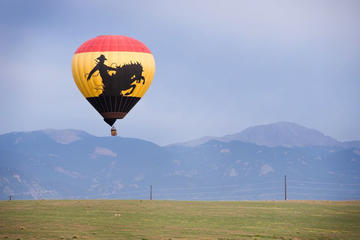
Colorado Springs Sunrise Hot Air Balloon Flight
About the author:
Dedra Montoya is a second-grade teacher in Colorado Springs with a passion for writing. She recently took a three-day Ultimate Travel Writers Workshop in San Diego to prepare her for pursuing a “second career” as she closes in on retirement. She has been published in Statement: the Journal of the Colorado Language Arts Society in the Fall 2012 issue; Her blog written when she taught a half-year in England a couple of years ago is called Trading Lives: An American Teacher in England dedra-montoya.blogspot.com. Since taking the travel writers workshop, she “sees” stories everywhere and writes/researches every moment she gets!
All photos are by Dedra Montoya and Kristin Nielson-Drake:
Victor sign before you head into Victor, nicknamed City of Mines
One of the many goldmines in the area…this one’s still active
Victor Trading Company
Sam and Karen Morrison standing in front of their store (“American Gothic” style)
Sam and Karen working working on the broom winder
The sewing cuffs Sam wears to protect his hands from needle jabs



